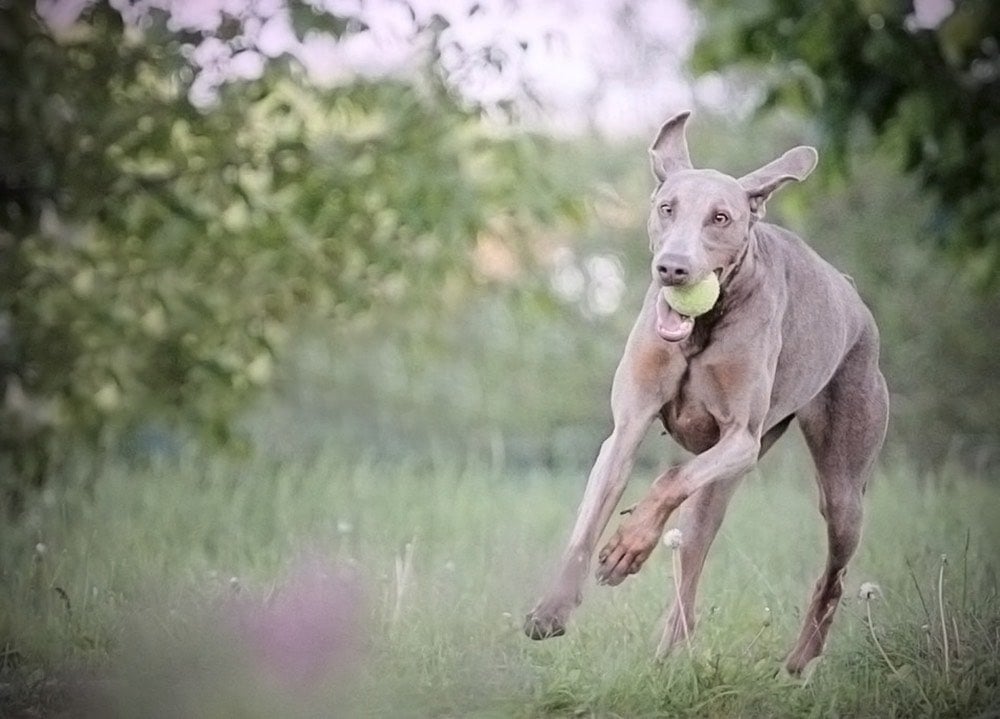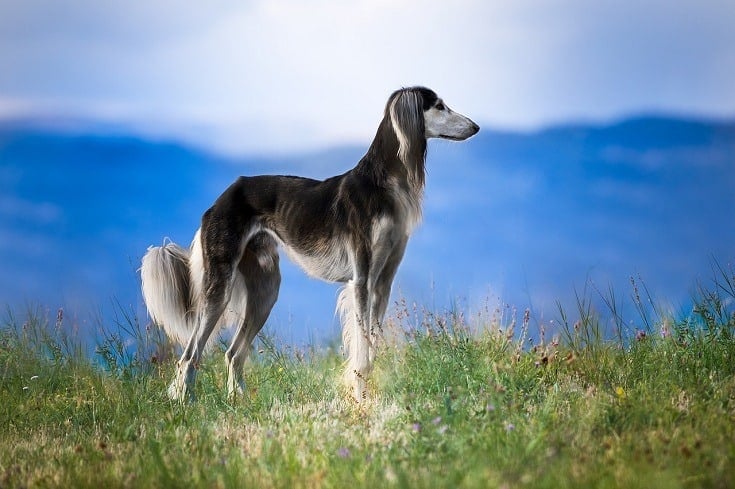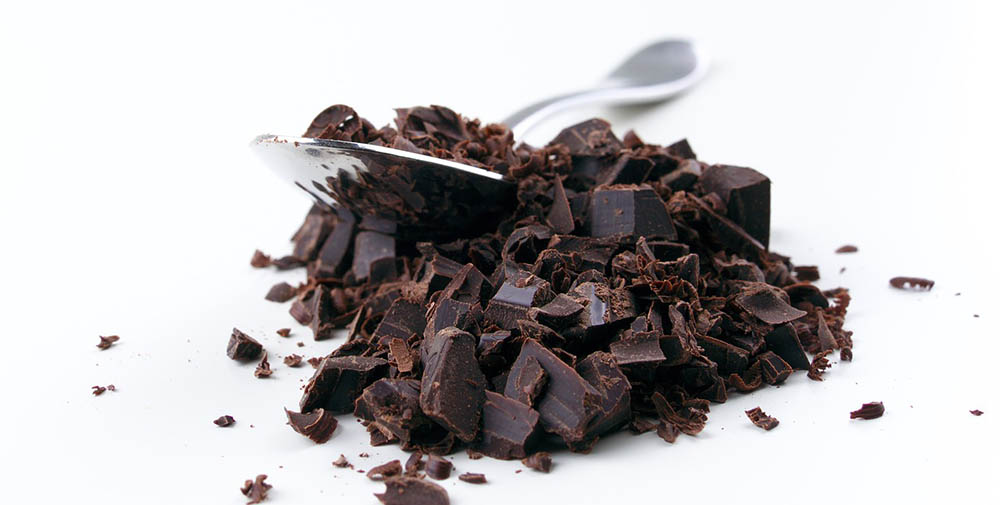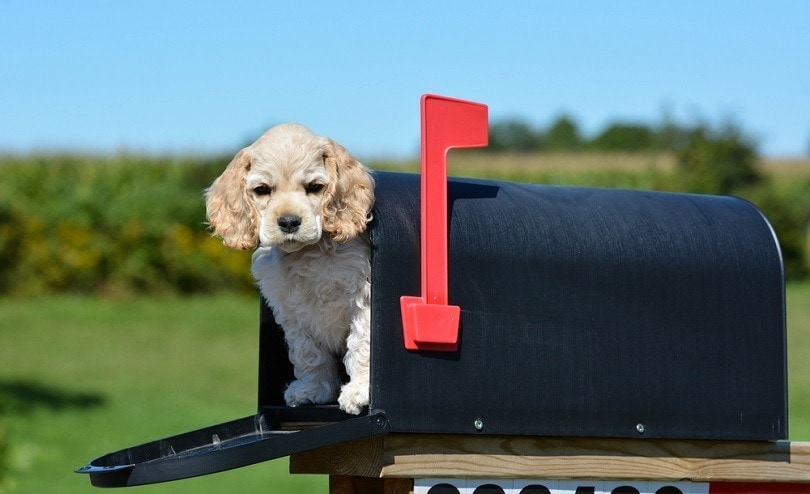Height:
25 to 30 inches
Weight:
60 to 80 pounds
Lifespan:
10 to 14 years
Colors:
Black, brown, brindle, blue, red, fawn
Suitable for:
Active homes, families with older children, homes with multiple dogs, experienced dog owners
Temperament:
Affectionate, friendly, gets along with other pets
What do you get when you cross two powerfully muscular domestic dog breeds, one known for its intimidating presence and the other for its incredible sprinting speed? Oddly enough, the resulting mix of a Dobermann Pinscher and Greyhound turns out to be as kind and gentle of a breed as you might ever meet.
Aptly named the Doberman Greyhound, this recently created designer dog breed defies expectations to become an amazingly friendly breed that loves spending time with children. They moderate the extreme qualities of both parent breeds, resulting in a mild-mannered dog who loves nothing more than to play, run, and cuddle with its family.
Are you considering bringing a Doberman Greyhound into your home and life? Read the following sections for loads of tips and tricks on every aspect of a Doberman Greyhound’s life.
Doberman Greyhound Puppies – Before You Buy…
Understanding a breed’s characteristics is the most important step you can take towards becoming a responsible dog owner. With the average Doberman Greyhound living to be 10 to 14 years of age, adopting one of these long-lived dogs is a big commitment.
Before you jump into buying a new puppy, it’s worth knowing that designer dog breeds like the Doberman Greyhound can be harder to predict the personality of than traditional purebred dogs. Since most designer dogs have only been around for a few decades at most, their breeds have had less time to stabilize into predictable patterns.
This means that, in trying to understand the Doberman Greyhound, it’s best to examine each of its parent breeds: The Greyhound and the Dobermann Pinscher. Let’s take a quick look at each before discussing how their personalities meld in the Doberman Greyhound.
The Doberman Pinscher, originally known in Germany simply as the Dobermann, was developed in the late 1800s. Bred specifically to look powerful and intimidating, the Dobermann would accompany tax collectors for protection. They are intelligent, alert, and unfailingly loyal to their owners, though sometimes stubborn in the early stages of training.
Often stereotyped as being aggressive or overly prone to anger, the Doberman Pinscher that we know and love today has had many of its aggressive traits bred out through years thanks to a concerted effort by dedicated breeders. What has remained is the Dobermann’s high intelligence, quick response to training, and fearless protectiveness of its owners.
Greyhounds have long been the star of dog racing tracks, thanks to their original development as game chasing sighthounds. Trained to be indifferent or suspicious of strangers, these lithe and powerfully muscled dogs can display great affection towards anyone that they get familiar with.
Docile, laid back, and easy-going, the Greyhound has become a popular family pet thanks to the large number of retired racing Greyhounds up for adoption. Despite their reputation as active and energetic dogs, Greyhounds don’t need hours of daily exercise – just the occasional good sprint.
Doberman Greyhounds fall gracefully in the middle of the character traits on both sides of their family tree. Protective but not aggressive, energetic but not annoying, and generally easy to train, they make an excellent choice for families or single owners alike. Initial training requirements can be tough on inexperienced owners, but with the help of an obedience school, the Doberman Greyhound will take quickly to further training.
What’s the Price of Doberman Greyhound Puppies?
Both the Doberman Pinscher and Greyhound pure breed dogs can command impressive prices if they have a respected pedigree, with maximum prices ranging from $4,500 to $7,500, respectively. While there is little information available for the average prices of this rare designer dog breed, it’s safe to say that you should be prepared to pay $1,000 or more for a Doberman Greyhound puppy from a reputable breeder.
3 Little-Known Facts About Doberman Greyhound
1. Doberman Greyhounds do best in quiet environments.
Owing to the relative sensitivity of its Greyhound parent, and alert protective nature of the Dobermann side, Doberman Greyhounds will be at their most comfortable and happiest living in a quieter household. This makes them a natural companion to people with rural homes, families with older children, or older singles and couples.
2. They have impressive speed and stamina.
Greyhounds are known for their ability to sprint at incredible speeds for short distances, while Doberman Pinschers have been bred for stamina. Combining the two creates a designer dog breed that has the capacity for amazing bursts of speed, as well as sustained bouts of endurance running. Despite this athletic nature, most Doberman Greyhounds prefer to spend large swaths of their day lounging around like couch potatoes.
3. Mixing the Doberman Greyhound’s purebred parents has benefited its health.
As with any purebred dog, both Doberman Pinschers and Greyhounds are prone to a variety of serious hereditary health complications. Thankfully for the Doberman Greyhound, however, the genetic sources of these maladies seem to balance each other out during interbreeding. The resulting designer dog enjoys significantly improved health compared to either of its parents.

Temperament & Intelligence of the Doberman Greyhound
A model dog breed for combining great intelligence and a mild-mannered nature, the Doberman Greyhound is sure to delight anyone who appreciates a more laid-back home environment. They can become fiercely protective of their families, but rarely possess the aggressive instincts necessary to act as guard dogs. Instead, they make excellent companion animals that appreciate quiet time just as much as daily walks.
Are These Dogs Good for Families?
The Doberman Greyhound is an excellent choice for families with older children but may be overwhelmed by the high energy and activity levels of young children. They’ll often develop a highly protective nature around adults and children alike and should be kept on a leash whenever they’re walked as they have a tendency to sprint away at a moment’s notice.
Do Doberman Greyhounds Get Along with Other Pets?
Depending on the individual dog, your Doberman Greyhound will either get along very well with small animals or ceaselessly bother them. Some Greyhounds and Doberman Pinschers are possessed of a noticeable prey drive that will encourage them to chase small animals, while others are not. Either way, with a small amount of training, Doberman Greyhounds will easily take to getting along well with other dogs.
Things to Know When Owning a Doberman Greyhound
Are these lovable designer dogs sounding more appealing to you? If you’re convinced that their personalities and temperaments are well suited to your home, you’ll still need to consider their health and exercise requirements. Read on to learn the basics about each of these important areas of a Doberman Greyhound’s life.
Food & Diet Requirements
Doberman Greyhounds are large dogs with even bigger appetites, so you should be prepared to budget for quite a bit of high-quality dry dog food each month. Choose a brand that’s formulated for active dog breeds and split their three cups of dry dog food per day into three or more meals; this will help prevent them from eating too quickly and giving themselves painful bloating.
Exercise
With exercise requirements somewhere between the extremely high energy of a Dobermann and the laid-back relaxation of a Greyhound, Doberman Greyhounds seem more than anything to be happy with any amount of exercise you give them. They’ll happily spend weekends on the couch with you, as long as there are plenty of high-stakes games of fetch during the week. Aim for about an hour of moderate to vigorous activity with your Doberman Greyhound per day, and they’ll stay at a healthy weight throughout their life.
Training
Once you get past the Dobermann side’s initial stubbornness, Doberman Greyhounds become incredibly easy to train and highly obedient to commands. Unless you have significant experience training dogs, it’s wise to invest in obedience training from a young age for this breed; that way, as they grow up, you’ll have a much easier time continuing to reinforce good habits.
Grooming ✂️
With their relatively lightweight and sparse coats, Doberman Greyhounds don’t require much grooming to keep them looking their best. Be sure to schedule regular tooth brushing, nail trimming, and ear cleaning appointments with a groomer, or learn to perform these necessary grooming services at home about once a month.
Health and Conditions
Enjoying greater stability of health than either of their ancestors, the Doberman Greyhound is still prone to rare instances of a few inherited conditions. Keep your eye out for those listed below:
- Hypothyroidism
- Skin sores and lesions
- Von Willebrand’s disease
- Hip dysplasia
- Cervical vertebral instability
- Dilated cardiomyopathy
Male vs Female
Female Doberman Greyhounds will generally stand shorter and weigh less than their male counterparts. Males have been known to be slightly lazier than females on average, though this doesn’t hold true for every dog. Individual differences in personality, energy levels, and temperament are more noticeable than any differences determined by sex.
Final Thoughts
The Doberman Greyhound is certainly a unique mix of dog breeds, thanks to the merging of seemingly opposite family tendencies from both of its parents. Loyal and affectionate, these peace-loving dogs can be highly protective companion animals that enjoy long, healthy lives. If you’ve been looking for a dog that will settle into a quiet home without demanding too much, the Doberman Greyhound might be the perfect pet for you.
See also: 10 other adorable greyhound mix breeds
Featured Image Credit: Best dog photo, Shutterstock










